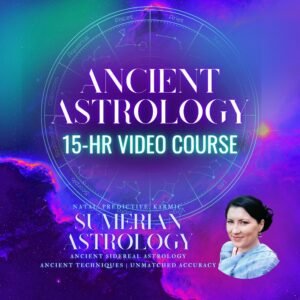The Babylonian Zodiac
The Original 12-Sign Sidereal Zodiac
In this article, we’ll explore the the development and original meanings of the 12-sign Babylonian Zodiac.
But if you’re truly interested in this topic, I highly recommend my 15-hour Ancient Astrology Video Course, which goes into university-level depth on the origins and development of astrology.
Origins of the Babylonian Zodiac
The Babylonian zodiac is composed of the 12 zodiac signs we all know and love. It was developed over millennia via reduction of the original 18-constellation Sumerian Zodiac, which you can read all about in my article/series The Path of the Moon. You can go into MASSIVE depth on the origins of astrology in my 15-hour video course.
The 18 constellations in the Path of the Moon were:
- MULMUL 𒀯𒀯 Many Stars/Star Cluster—the Pleiades (in Taurus)
- MULGU4.AN.NA 𒀯𒄞𒀭𒈾 Bull of Heaven—Taurus
- MULSIPA.ZI.AN.NA 𒀯𒉺𒇻𒍣𒀭𒈾 True Shepherd of Anu—Orion
- MULŠU.GI 𒀯𒋗𒄀 Old Man/Enmešarra—Perseus
- MULGÀM/MULZUBI 𒀯𒆛/𒀯𒉽𒈿 Shepherd’s Crook—Auriga
- MULMAŠ.TAB.BA(GAL.GAL) 𒀯𒈦𒋰𒁀(𒃲𒃲) (Great) Twins (Lugalirra and Meslamta’ea)—Gemini
- MULAL.LUL 𒀯𒀠𒈜 Deceptive Digger—Cancer
- MULUR.GU.LA/MULUR.MAḪ 𒀯𒌨𒄖𒆷/ 𒀯𒌨𒈤 Great Carnivore/Exalted Lion—Leo
- MULAB.SÍN/MULÀBSIN 𒀯𒀊𒉆/𒀯𒀳 Furrow—Virgo
- MULZI.BA.AN.NA 𒀯𒍣𒁀𒀭𒈾 and MULĜIŠ.ÉRIN 𒀯𒄑𒂟 Scales—Libra and lower part of Virgo
- MULĜÍR.TAB 𒀯𒄈𒋰 Scorpion—Scorpius and Legs of Ophiuchus
- MULPA.BIL.SAĜ 𒀯𒉺𒉋𒊕 Pabilsag (Ninurta)—Sagittarius
- MULSUḪUR.MÁŠ(KU6) 𒀯𒋦𒈧(𒄩) Goat-Fish—Capricorn
- MULGU.LA 𒀯𒄖𒆷 Great One (Enki/Ea)—Aquarius
- MULKUNMEŠ 𒀯𒆲𒎌 and MULZIBME 𒀯𒍦𒈨 The Tails of the Great Swallow—Western Fish of Pisces
- MULSIM.MAḪ 𒀯𒉆𒈤 The Great Swallow (Southwest Pisces, Epsilon, Pegasi)
- MULA.NU.NI.TUM 𒀯𒀀𒉡𒉌𒌈 and MULLU.LIM 𒀯𒇻𒅆 Anunitum—(Northeast Pisces, Andromeda)
- MULLÚ.ḪUĜ.ĜÁ 𒀯𒇽𒂠𒂷 Hired Man—Aries, Triangulum and the Head of Cetus
During the Babylonian period, these were reduced to the 12 Babylonian Zodiac signs:
- MULGU4.AN.NA: 𒀯𒄞𒀭𒈾 Bull of Heaven—Taurus
- MULMAŠ.TAB.BA(GAL.GAL): 𒀯𒈦𒋰𒁀(𒃲𒃲) (Great) Twins (Lugalirra and Meslamta’ea)—Gemini
- MULAL.LUL: 𒀯𒀠𒈜 Deceptive Digger—Cancer
- MULUR.GU.LA/MULUR.MAḪ: 𒀯𒌨𒄖𒆷/ 𒀯𒌨𒈤 Great Carnivore/Exalted Lion—Leo
- MULAB.SÍN/MULÀBSIN: 𒀯𒀊𒉆/𒀯𒀳 Furrow—Virgo
- MULZI.BA.AN.NA: 𒀯𒍣𒁀𒀭𒈾 Scales—Libra and lower part of Virgo
- MULĜÍR.TAB: 𒀯𒄈𒋰 Scorpion—Scorpius and Legs of Ophiuchus
- MULPA.BIL.SAĜ: 𒀯𒉺𒉋𒊕 Pabilsag (Ninurta)—Sagittarius
- MULSUḪUR.MÁŠ(KU6): 𒀯𒋦𒈧(𒄩) Goat-Fish—Capricorn
- MULGU.LA: 𒀯𒄖𒆷 Great One (Enki/Ea)—Aquarius
- MULKUNMEŠ 𒀯𒆲𒎌 and MULZIBME: 𒀯𒍦𒈨 The Tails of the Great Swallow—Western Fish of Pisces and MULSIM.MAḪ: 𒀯𒉆𒈤 The Great Swallow (Southwest Pisces, Epsilon, Pegasi)/MULA.NU.NI.TUM: 𒀯𒀀𒉡𒉌𒌈 Anunitum—(Northeast Pisces, Andromeda)
- MULLÚ.ḪUĜ.ĜÁ: 𒀯𒇽𒂠𒂷 Hired Man—Aries, Triangulum and the Head of Cetus
A Lot Has Changed Since Babylonian Times
Since the development of the Babylonian zodiac, a lot has changed. Most of the original meanings of the Babylonian zodiac signs have been diluted, perverted, or lost—at least as far classical and modern astrology are concerned.
NOTE: you don’t already have it, I highly recommend buying Babylonain Star-Lore by Gavin White as soon as possible. It’s a phenomenal reconstruction of not just the Babylonian zodiac signs, but the ancient Mesopotamian constellations in general. While it’s not a manual on how to practice Babylonian astrology, it’s a must-have for anyone interested in the origins of astrology.
Ancient Astronomy
Until quite recently in mankind’s history, astronomy and astrology were considered one and the same. Ancient people saw the stars, constellations, and planets as being endowed with spirits and deities, making both astronomy and astrology the oldest and most sacred of sciences.
Ancient astronomical calendars have been found throughout the world. The ancient astronomical observatory Gobekli Tepi is now believed to be at least 12,000 years old. Archaeologists can only speculate as to what, if any, religious (or astro-theological) significance was attributed to it. The same cannot be said for the astronomy which rose out of ancient Mesopotamia.
Astrology as we Know it Emerges
Along with being the first to create and codify written language, known as Cuneiform, the Sumerians were the first to track and record in detail, the movements of the Moon, Sun, and stars. There is evidence that their astronomical knowledge may have been passed down for thousands of years prior to the rise of their civilization, but that’s a topic for another day.
Anuma Anu Enlil
The Babylonian star catalogs are among the first and most comprehensive codification of astronomical observation. Among the earliest of these compilations is a is U4 AN.NA dEN.LIL.LA 𒌓𒀭𒈾𒀭𒂗𒆤𒇲 (lit. When Anu and Enlil); also known as Enuma Anu Enlil (EAE).
The text is composed of 68-70 astrological tablets, which include anywhere from 6,500 to 7,000 specific astrological predictions. One of the main purposes of keeping such thorough astronomical-astrological records was to predict the state of the king and the nation, although natal and predictive astrology were performed for common folk too, despite what some have claimed.
Many believe copies of the Babylonian astronomical tablets made their way to India via trade routes between 400 and 300 BCE, which is likely why the zodiac of Vedic astrology is almost identical to the Babylonian Zodiac.
It’s interesting to note that EAE places primary importance on the movements of the Moon, followed by the Sun. Eclipses and weather patterns also affected astrological predictions. It might come as a surprise, but the movements of the other planets were tertiary. In fact, only the last 20 tablets concern the planets and stars.
MUL.APIN
One of the most significant star lists in Babylonian astrology is a document called MUL.APIN 𒀯𒀳, which translates as The Plow Star/Constellation. It’s believed to have been compiled in its canonical form around 1000 BCE, although evidence suggests the information it contained may have existed for centuries or millennia before its canonization.
It contains 71 stars and constellations, as well as their rising and setting times. The stars are also listed with an associated deity, and in some cases, a short epithet, giving clues to his or her nature. It’s within the first of the two tablets we find the list of stars and constellations which follow the Path of the Moon.
As stated earlier, these 18 major constellations became the 12 constellations of the Babylonian Zodiac. These Babylonian zodiac signs made their way to Egypt, Greece, and India.
Bull of Heaven
Taurus
The first of the 12 signs in the Babylonian zodiac was GU4.(GAL).AN.NA 𒀯𒄞(𒃲)𒀭𒈾, Bull of Heaven or Heavenly Bull (lit. Sky’s Bull). It’s no surprise that Taurus (and the Star Cluster—the Pleiades) was listed first in the Babylonian Zodiac, as it was Taurus—not Aries—which dominated the spring skies at the end of the last ice age, just as civilization was taking off in Mesopotamia. In other words, Taurus marked the vernal point—not Aries.
NOTE: Despite what Tropical Astrologers would have you believe, the sun currently rises in the constellation of Pisces on the Vernal Equinox (March 21st), which I demonstrate in this YouTube video. If you’d like to get more acquainted with the actual placements of the planets in the constellations (Sidereal Astrology), I recommend downloading Stellarium Planetarium Software for free at Stellarium.org.
Springtime and the Precession of the Equinoxes
Because the earth wobbles on its axis, every 72 years, the vernal point moves backward 1 degree; a phenomenon known as precession. It’s this backward motion that has resulted in the 24 degree difference between the Tropical Zodiac and Sidereal Zodiac.
In Mesopotamia, the Spring Equinox marked the Sumerian New Year, Akitu. Unlike in milder European regions where seeds are sewn in the spring, this was the harvest season in the Fertile Crescent.
Because of this, Taurus was intimately associated with the harvest, bounty, and wealth. As spring preceded summer—the season of death, there would also have been a sense of finality and danger wrapped up in the mythos.
Gu(gal)anna in Mythology
Gugalanna was the first husband of Ereškigal 𒀭𒊩𒌆𒆠𒃲 (DEREŠ.KI.GAL), the Goddess of the Underworld, and elder sister of Inanna 𒈹. When Inanna was spurned by Gilgameš 𒄑𒉋𒂵𒎌 (Sumerian Bilgames), she implored An 𒀭, god of the celestial sky, to release the Heavenly Bull into her control so she could enact vengeance on the defiant god-king.
An reluctantly agreed and lent Inanna the Heavenly Bull, whom she set upon Gilgameš’s kingdom. There, he consumed the all rivers and vegetation until he was killed by Gilgameš’s companion, Enkidu 𒂗𒆠𒄭 (EN.KI.DU10).
Upon his death, his body was butchered and fed to the needy of the city, save for a haunch, which was thrown at Inanna as a final insult. Inanna’s priestesses performed lamentations, and Inanna herself descended into the underworld to console her sister, sparking one of the most celebrated stories in Sumerian mythology, the Descent of Inanna.
Taurus as a Divine Servant
Though a deity himself, Gugalanna was a servant of the supreme deity An, the Sumerian king of the gods, lord of the heavens, and god of creation, justice, and the cosmos. As his servant, Gugalanna, and thus Taurus would have been associated with all of these.
His wife Ereškigal’s name translates as Queen of the Earth. As ruler of the land of the dead, Kur 𒆳, she had sole authority to create and enforce the laws of the Underworld. As her consort, Gugalanna would have played a role in governing the land of the dead.
While not mentioned in the Epic of Gilgamesh specifically, it’s important to note that Gugalanna’s son with Ereškigal was Ninazu 𒀭𒊩𒌆𒀀𒋢, a benevolent god of healing. With the Spring Equinox being a time of bounty, it’s not a stretch to imagine some of Ninazu’s healing ability was passed down from at least one of his parents, and Gugulana is the most likely candidate.
Finally, we must consider Inanna’s role in this story. As the youthful goddess of love, sexuality, fertility, and war, she is unquestionably the most important female deity in ancient Mesopotamia. As her champion, the Heavenly Bull is not only a tool of divine retribution but also a divine sacrifice. As her proxy, he is a force of sexuality, fertility, and ferocity—all attributes associated with bulls the world over.
The Egyptian Bull God Apis
Ritual sacrifice and ceremonial burials of bulls were common in ancient Egypt. We can get a better understanding of why by looking at the mythology of the bull-god Apis.
Originally a fertility and agricultural deity, Apis is one of the earliest deities in Egyptian history. Just as Gugalanna was the servant of the supreme creator An, Apis was a servant of Ptah, the Egyptian God of Creation. According to mythology, Ptah chose Apis to act as his emissary because of his courage, strength, and tenacity. But unlike Gugalanna, who simply acted on behalf of the Sumerian gods, Apis was considered a manifestation of Ptah.
In later years, Apis become an aspect of Osiris, who, like Gugulanna, was sacrificed, ruled the underworld, and was resurrected. He was associated with kind justice, love, youthfulness, and tranquility. Osiris was also closely associated with the annual flooding of the Nile, and thus the regeneration of life and fertility.
The similarities between the Sumerian Gugalanna and the Egyptian Apis are clear in their association with superior creative and judicial deities, their reign in the underworld, their divine sacrifice, as well as their associations with fertility, love, youthfulness, and power.
Taurus' True Astrological Associations
When we consider all of this, we see can see Taurus’s ancient astrological associations should be no less than:
Bounty, courage, creation, death, destruction, ferocity, fertility, greatness, hunger, justice, kingship, life, nobility, nourishment, power, prosperity, responsibility, retribution, righteousness, sacrifice, service, sexuality, strength, sustenance, vengeance, vitality, war, and wealth.
The Great TWins
Gemini
In the Babylonian zodiac, the constellation we now know as Gemini was called MASH.TA.BA, or “the Great Twins.” This is an abbreviated form of MUL.MASH.TAB.BA.GAL.GAL, which translates as, “the Great Companions.”
To understand the astrological associations of this ancient zodiac sign, we have to look at the constellation from two perspectives: the first being as representing two different aspects of the Sumerian god, Nergal.
Meshlamtaea and Lugalirra
In Babylonian astronomy, the Great Companions were called: Meshlamtaea, or “the one who has arisen from the underworld;” and Lugalirra, or “the mighty king”.
Both names are epithets given to Nergal, the King of the Underworld and the God of War and Pestilence. Now, before you judge the God of Plagues too harshly, you’ll want to take a look at his mythos.
Nergal was the son of Enlil, a major god of both creation and destruction, and Ninlil, a goddess of agriculture and healing. As the story goes, Enlil was banished to the underworld for seducing Ninlil, who followed her consort to the lands of the dead where she bore his children; Nergal among them.
Both of his parents were relatively benevolent deities, and you’ll recall from the story of the Heavenly Bull, an association with the Land of the Dead does not a malevolent deity make.
Nergal Was Arguably Benevolent
Despite being associated with death, war, and pestilence, Nergal was not without his benevolence. His Northern Mesopotamia equivalent, Aplu, was clearly seen as both a bringer of and protector from all of the aforementioned calamities.
If you’re wondering how a deity associated with death and destruction could possibly have benevolent traits, then consider how Nergal came to be associated with these in the first place.
Nergal as an Aspect of Shamash
Nergal wan an aspect of Shamash, the God of the Sun; specifically, the midday and mid summer sun: the hottest and deadliest phases of Shamash. Unlike in European climates where high summer is considered lush and vibrant, this would have been seen as a time of death and drought.
The Sun-God Shamash was a God of Law and Justice. He was also known to deliver people from the grip of demons. As an aspect of Shamash, Nergal must have certainly shared at least some of these attributes. In fact, both Shamash and Nergal were often depicted as lions, or having the head of lions.
Nergal is also closely connected to the bull, not surprising, considering in later versions of mythology, it is Nergal, not Gugalanna, who is consort to Ereshkigal, the Queen of the Underworld.
There must have been enough similarity between the God of Plagues and the Heavenly Bull for the switch to have been made successfully. Certainly, both deities have associations with enacting justice through destructive means. And both constellations representing them take a prominent place in the sky just as the vegetation begins to die and the dry summer months set in.
Possible Egyptian Equivalent
Egyptian mythology also contains a lion-headed God of War: Maahes. Like Nergal, he was also a son of the God of Creation, Ptah. And like Nergal’s father Enlil, Maahes was associated with winds and storms.
His mother was Bast, a ferocious warrior and fierce protector. Maahes continues her legacy as a bringer of bloody but righteous justice (not unlike Gugalanna).
While Maahes does not rule the Underworld as Nergal did, he does fight Apep, the demon-like serpent God of Darkness. This fact is particularly interesting considering how the constellation of Gemini was viewed in Mesopotamia.
The Great Companions: Guardians of the Underworld
In the Babylonian star maps, the Great Companions are depicted as warriors dressed for battle and brandishing weapons; very much unlike their modern depictions. The two warriors were seen as guardians of the underworld.
Since the approaching summer was the season of death and pestilence, the ancients saw the veil between the lands of the living and dead as being dangerously thin. Thus, it would have been up to the two guardians to prevent demons from escaping during the coming Summer Solstice, when they could wreak havoc during an already precarious time.
The protective theme of the constellation can be seen in the statues of the Companions found buried in doorways throughout ancient Mesopotamia.
As we’ve can see, protection would have almost certainly been associated with the destructive underworld deity. But there is another aspect of the Sumerian God of War that we cannot overlook.
Nergal’s Softer Side
You’ll recall from a few paragraphs ago that Nergal was married to Ereshkigal, the Goddess of the Land of the Dead. The circumstances of how this union came about are quite telling of Nergal’s true nature.
According to the myth, Nergal insulted one of Ereshkigal’s messengers, and subsequently the underworld goddess, herself. He descended into the Underworld, either to beg her forgiveness or accept her punishment.
While there, he saw her undressing for a bath and fell madly in love. He swiftly embraced her and they promptly engaged in what amounted to six straight days of coitus.
For reasons unknown, Nergal slipped away when Ereshkigal was asleep and returned to the celestial realm.
When Ereshkigal found out, she went into a fit of rage and demanded the celestial gods force her lover to return. The gods were unsuccessful, but Nergal eventually sought out the Underworld of his own free-will.
Upon his return, he laughed happily and immediately embraced her in a passionate kiss. They then return to their nonstop lovemaking, after another week of which Nergal was declared King of the Underworld.
Gemini’s Ancient Associations
As we’ve seen, the original astrological associations of the Zodiac Sign of Gemini would have been quite different from “traditional” interpretations.
When we consider ancient Mesopotamian and Egyptian myths, the astrological associations for Gemini could be more accurately described as:
Companionship, conflict, death, destruction, disease, drought, evasion, exorcism, ferocity, fire, heat, illness, indecision, justice, love, lust, order, partnership, passion, power, righteousness, sex, strength, stubbornness, summer, war, and youthful folly.
The Deceptive Digger
Cancer
In the Babylonian zodiac, the constellation of Cancer was originally called “AL.LUL,” a Sumerian word which literally translates as “deceptive digger.”
While the Akkadian word “alluttu” does translate as “pincers,” no image of a crab has ever been found on a boundary stone making it unlikely that the constellation was ever seen as such. However, there is another “deceptive digger” that features quite prominently in its stead: the turtle.
The Turtle in Sumerian Mythology
Unlike some of the other constellations, AL.LUL doesn’t represent a major god or mythological figure specifically; at least not that we know of. What we do know is that the turtle was associated with Enki, the Sumerian God of Creation, Wisdom, and Water (can you say Aquarius?).
Enki was attributed with shaping the world with his great magic. He was the God of subterranean and fresh waters, and as such was attributed with fertilization of the land. He was also responsible for keeping and distributing the Gifts of Civilization.
In mythology, Ninurta, a Sumerian God of War and Hunting, coveted these gifts and decided to steal them. Enki intuitively sensed Ninurta’s plans and fashioned a turtle to stop him before he could enact his thievery.
The turtle grabbed Ninurta from behind by the tendon, dug a great pit with its claws, and pulled Ninurta down into it.
Like the Bull of Heaven, Enki’s turtle is a champion of a superior, creator deity. But unlike Gugalanna who is tasked with distributing divine retribution, the Turtle is given to a preemptive attack which he carries out from a position of stealth.
Unfortunately, the poem of “Ninurta and the Turtle” is incomplete, and we never learn his fate. The last we hear of him, the turtle is relentlessly gnawing at Ninurta’s ankle as Enki mocks the war-god from on high.
Enki, the Lord of Fresh Water
Enki was called the Lord of Waters. Fresh water was seen as his semen and it was he who was directly responsible for fertilizing the land, especially through flooding. We know that omens surrounding the zodiac sign of Cancer were used to predict water levels in Babylonian astrology.
It is not unreasonable to think that Enki, who was responsible for both pouring and holding back the waters, might send his emissary, the biting turtle, just as the dry summer months were reaching their peak in the Fertile Crescent.
This assumption is supported by the fact that within the Babylonian star catalogs, AL.LUL is mentioned in association with the water levels of the Tigris and Euphrates rivers.
As a constellation of prominence during the season of death, AL.LUL would have been closely associated with death and the underworld, a theme we can see reoccurring his Egyptian equivalent: the scarab.
The Egyptian Connection
In Egyptian astronomy, the constellation of Cancer was seen not as a crab or turtle, but as a scarab beetle – a creature closely associated with the daily cycle of the sun.
The ancient Egyptians saw the similarity between the scarab beetle pushing balls of dung across the desert and the sun being pushed through the sky, past the horizon and into the underworld, only to emerge again the next day. Thus, the scarab was associated with birth, death, and regeneration, as was the solar deity Khepri, who embodied this process.
Like Enki, Khepri was associated with the creation, or shaping of the world. He was also considered to be an aspect of the sun’s cycle: the morning sun which rises up from beneath the horizon and out of the underworld.
Like Khepri, Enki’s turtle rises up from beneath the earth, only to eventually return to the underworld – a clear reference to the cycle of birth, life, and death. We know that the Egyptians associated turtles with the Underworld, and interestingly enough, Enki himself resides in a subterranean ocean called Abzu.
Enki was the God of Wisdom and Magic. He also protected humanity from illness, calamity, and evil spirits. As his champion, the turtle would have shared these aspects. Incidentally, the Egyptians saw the turtle as being endowed with all of these properties. They used the turtle and tortoise in medicine and magic, as a protection from illness, death, and demons.
Cancer’s Ancient Associations
After close examination, we see that the ancient people of Mesopotamia and Egypt most likely saw the Zodiac Sign of Cancer as having the following associations:
Creation, cunning, death, deception, defense, determination, fearlessness, fertility, gnawing, healing, intelligence, intuition, justice, life, magic, order, penetration, pursuit, power, protection, psychic perception, regeneration, relentlessness, sacrifice, spiritual protection, stealth, strength, tenacity, the Underworld, water, and wisdom.
The Exalted Carnivore
Leo
Many people associate the zodiac sign of Leo with power, strength, and royalty. While the people of ancient Mesopotamia certainly attributed the lion with these, it also held much darker connotations.
In the Babylonian Zodiac, the constellation we now know as Leo, was once called UR.GU.LA, which literally translates as “Great Carnivore.” In ancient times, the celestial lion gained prominence in the Mesopotamian sky just as the dry, deadly summer was reaching its peak.
This was a time of drought, pestilence, and death, and the sign of Leo was no doubt closely associated with all of these. While it’s not certain who the celestial lion represents, there are a few Mesopotamian deities who fit the bill.
Nergal and Shamash
With its majestic mane and golden fur, the lion was a natural choice as a symbol of the sun. Perhaps that’s why both Shamash, the solar God of Law and Justice, and Nergal, the solar God of War and Pestilence, were often depicted as such. It’s far more likely that the constellation of Leo would represent Nergal, especially considering that the God of Death and Drought was considered the midday and midsummer aspect of Shamash.
Some have suggested that Leo depicts the Sumerian Inanna, who was often referred to as the “Lioness of Heaven.” However, I feel she is a less likely candidate, as she is clearly represented in a nearby constellation, not far below the lion’s shoulder.
Inanna’s Connection to the Lion
Still, the connection between the lion and the Goddess of War should not be overlooked. She was known to posses a sacred lion which accompanied her into battle. If nothing else, this reminds us of the lion’s connection to war; summer being the preferred time for leading foreign campaigns.
Humbaba
Another option would be the Sumerian Humbaba, the fire-breathing guardian of the cedar forest in the home of the Gods. In mythology, Humbaba was raised by Shamash, affirming his connections to both the sun and Nergal. As his representative, the monstrous lion would have possessed some of Shamash’s righteous attributes, making him a natural choice as protector and defender of the sacred wood.
Here we see a slight deviation from the ravenous carnivore of the summer constellation. Humaba, while a ferocious monster by any standards, is a protector of the natural world and divine order.
Lamassu
Humbaba isn’t the only protective lion in the ancient world. Statues of the Assyrian Lamassu have been found throughout Mesopotamia. The statues, which depict great lions with the heads of men, were placed at entrances of palaces, cities, and even homes as both a form of divine protection. For those who could harness its ravenous power, the lion was a symbol of strength and divine authority.
The Egyptian Sekhmet
One of the most notable lion figures in Egyptian mythology was Sekhmet, whose similarities to the Sumerian Nergal are impossible to overlook.
Like Nergal, the lion-headed Goddess was associated with war, carnage, pestilence, protection from death and illness, justice, and the midday sun. Oddly enough, both deities fell madly in love with their consorts upon first sight.
Sekhmet’s Similarities to Nergal
In mythology, the Sun God, Ra, Sent Sekhmet to punish humanity for their wickedness. She descended upon the land, which ran red with the blood of the masses.
Feeling sorry for human kind, Ra commanded Sekhmet to cease her violent work. However, she was mad with blood-lust and was only subdued after Ra tricked her into drinking a lot of red beer. Upon waking, she saw Ptah, the God of Creation, and fell hopelessly in love.
This is not unlike the story of Nergal, who after insulting the goddess Ereshkigal by refusing to kneel to her representative, fell madly in love with the Queen of the Underworld upon meeting her to make amends.
But Nergal isn’t the only Mesopotamian deity who shares similarities to Sekhmet. Humbaba, the adopted son of the Sun God, was a fire-breathing protector and servant of justice. Sekhmet, the daughter of the Sun God, Ra, was known as a fierce protector and servant of justice. And, it was said that she created the deserts simply by breathing upon the land.
Her ability to shape the world may be due in part to her association with her husband, Ptah, the God of Creation. It is well-known that Sekhmet was the patroness of doctors and healers in ancient Egypt.
Sekhmet’s Similarities to Nergal
In mythology, the Sun God, Ra, Sent Sekhmet to punish humanity for their wickedness. She descended upon the land, which ran red with the blood of the masses.
Feeling sorry for human kind, Ra commanded Sekhmet to cease her violent work. However, she was mad with blood-lust and was only subdued after Ra tricked her into drinking a lot of red beer. Upon waking, she saw Ptah, the God of Creation, and fell hopelessly in love.
This is not unlike the story of Nergal, who after insulting the goddess Ereshkigal by refusing to kneel to her representative, fell madly in love with the Queen of the Underworld upon meeting her to make amends.
But Nergal isn’t the only Mesopotamian deity who shares similarities to Sekhmet. Humbaba, the adopted son of the Sun God, was a fire-breathing protector and servant of justice. Sekhmet, the daughter of the Sun God, Ra, was known as a fierce protector and servant of justice. And, it was said that she created the deserts simply by breathing upon the land.
Her ability to shape the world may be due in part to her association with her husband, Ptah, the God of Creation. It is well-known that Sekhmet was the patroness of doctors and healers in ancient Egypt.
Mahees
Another son of Sekhmet, was the lion-headed Mahees, whose similarities to Negral, I’ve already outlined. Like the Mesopotamian Shamash, Mahees, too, was a fighter of demons, reaffirming Sekmet’s connection to the same.
Leo’s Ancient Associations
Regardless of which deity was represented by the constellation Leo, the theme of the celestial lion were similar throughout the region.
After taking a closer look, we can conclude that the ancients most likely associated Leo with:
Authority, conflict, consumption, creation (through destructive or transformative means), death, destruction, disease, divine protection, drought, exorcism, ferocity, fire, healing, heat, hunger, illness, indecision (see the story of Nergal and Ereshkigal), justice, law, love, lust, nature, offense, order, passion, power, protection, rage, righteousness, sex, strength, summer, and war.
The Seed Furrow
Virgo
Most people familiar with the zodiac sign of Virgo recognize the constellation as “the Virgin.” Many of its associations reflect this word’s innocent connotations. Words like “shy,” “modest,” and “quiet,” are often used to describe people born under this Sign.
These qualities were applied to the constellation by the Greeks and subsequently the Romans. However, in the ancient Babylonian zodiac, the constellation of Virgo had nothing to do with virginity, nor its supposed attributes.
AB.SIN: the Daughter of Sin (the Moon God)
The Babylonian Star Catalogs list the constellation Virgo as AB.SIN. The word can be understood as having two meanings. The first is ‘seed furrow’; a direct reference to the constellation’s association with agriculture and fertility.
In ancient times, AB.SIN rose on the eastern horizon in the early autumn; the time of seed-sowing in ancient Mesopotamia. The constellation itself depicted a celestial woman holding a stalk of barley representative of the harvest to come.
The movement of the Sun, Moon, and planets through her region of the sky were used to predict the success and failure of crops.
AB.SIN’s associations with fertility can also be seen in the word’s second translation: the Daughter of Sin.
Sin, the God of the Moon
Sin was the Akkadian God of the Moon, and the father of one of most prominent goddesses in the ancient world, Ishtar. Tales involving the goddess are many, but if any one best illustrates her celestial associations, it is probably the story of Gilgamesh and the Bull of Heaven.
Ishtar was taken by Gilgamesh’s beauty and offered him her hand in marriage. But the god-king refused, citing examples of how her great love so often resulted in a thing’s undoing. For example, Ishtar’s great love of animals resulted in their domestication, or enslavement.
“You loved the horse, so trustworthy in battle, but you decreed the whip, goad, and lash for him.”
Humans she loved, when struck by her often transformed into animals too.
“You loved the shepherd… but you hit him and turned him into a wolf, his own shepherd boys hunt him down and his dogs tear at his haunches.”
Furious; Ishtar demanded her father lend her Gugalanna, the Bull of Heaven, to kill Gilgamesh and destroy his city.
“If you do not give me the Bull of Heave, I shall strike… I shall set my face towards the infernal regions, I shall raise up the dead and they will eat the living. I shall make the dead outnumber the living!
Not wanting to incite a zobie apocolypes, Ishtar’s father gives her the Bull’s reins. She then sets him upon Gilgamesh and his city. The Heavenly Bull was slain however, and Ishtar called upon her cult of sacred prostitutes to weep over his headless body.
While Ishtar may have been young and beautiful, virginity and maidenly qualities were clearly not among her traits. The same can be said for her Sumerian counterpart, Inanna.
Despite her additional associations with knowledge and wisdom, the “Lady of Heaven” was known for inciting violence. In fact, battle was often poetically described as “the Dance of Inanna.”
The Egyptian Isis
In ancient Mesopotamia, the constellation Virgo was represented by the most prominent and powerful goddess in mythology, and the same was true in Egypt.
To the ancient Egyptians, the constellation Virgo was associated with Isis. Her worship spread to both the Greek and Roman empires, and it continues to this day within modern Paganism.
Myths surrounding Isis are many and far outside the scope of this article. Suffice to say, fertility, sexuality, procreation, and creative power in general were definitely her domain.
As mother of the god Horus, she was patroness of mothers. As wife and resurrection of Osiris, she was also patroness of wives, and held close associations to healing and magic, and wielded both powers of life and death.
Like Inanna, she was also associated with wisdom and knowledge, especially as it related to magic. However, unlike her Mesopotamian counterparts, Isis was rarely beset by rage and emotional instability. Generally speaking, she was an eternal nurturer and healer; the supreme incarnation of love and compassion.
As Christianity grew in popularity in the region, the Virgin Mary replaced Isis as the Mother of God, and her virginal properties were superimposed onto the constellation of Virgo.
Virgo’s Ancient Associations
Considering this, we can safely conclude that the ancient associations of the constellation of Virgo were:
Discover Astrology’s True Origins
There’s so much more to astrology’s origins than just the ancient meanings of the Babylonian zodiac signs. If you’re an aspiring astrologer, and you want to learn how to give people ancient astrology readings, I’m happy to share all of my knowledge with you.
Animals, authority, beauty, conflict, creation, cunning, death, determination, domestication, emotional sensitivity, fertility, healing, health, the land, life, magic (metaphysical energy), marriage, motherhood, nature, nurturing, preparation, power, rage, resurrection, sex, sexuality, vengeance, violence, and war.
Coming Soon...
I think I started writing this series—oh, goodness—it must have been six or seven years ago. At the time, I fully intended to do all 12 Babylonian zodiac signs. In all honesty, part of the reason I started with the Babylonian Zodiac instead of the Sumerian Zodiac (as far as article-writing was concerned), is because “Babylonian Zodiac” is searched far more than “Sumerian Zodiac”, despite the elder zodiac being far older and more detailed.
My goal was to just get the word out, as well as show some of the overlapping similarities to Egyptian and Mesopotamian mythology—something I admittedly don’t feel like writing more about right now.
For these reasons, I’m not sure if I’ll finish writing this series—at least not in it’s current incarnation. I mentioned at the beginning that I’m in the process of writing detailed articles about the constellations in the Path of the Moon.
I’ve been working on the article about the Star Cluster—the Pleiades—for the last few months. My intention was to write a 2,000-word article max. It’s grown to 7,000 words, and there’s no end in sight!
Anyway, I wanted you to know: 1) why I never finished this series, and 2) that a bigger and better version is on it’s way.
Be sure to subscribe for updates!
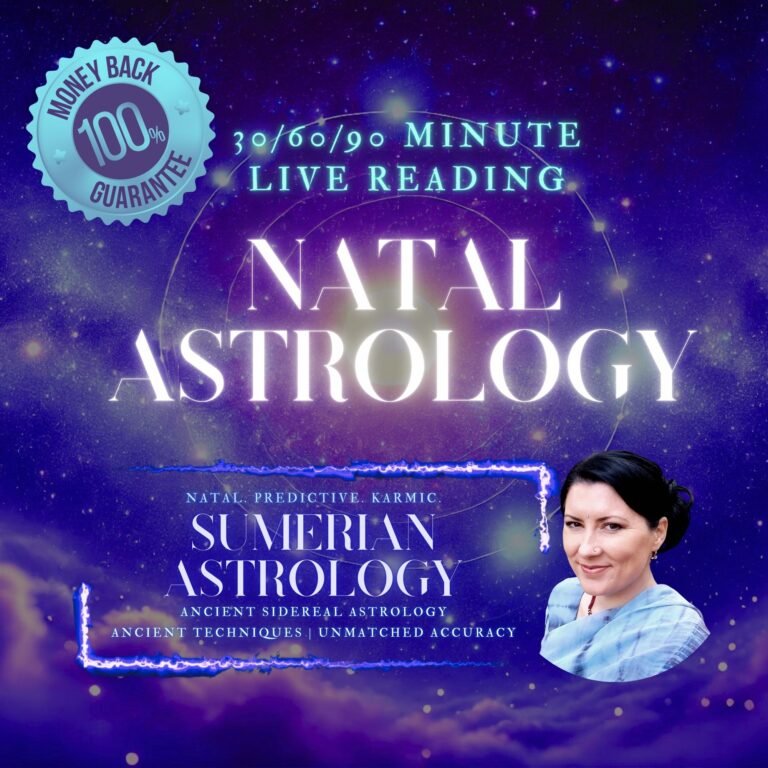
Natal Astrology Reading
Your Natal Chart is the foundation of all other prediction and comparison, which is why it’s recommended (though not required) for all first time readings with me!
Money-Back Guarantee: If it’s not the best Natal Astrology Reading you’ve ever had, I’ll refund your payment in full!
- Gain deeper self-awareness and clarity
- Understand your natural strengths and challenges
- Discover your ideal career and relationships
- Navigate life’s transitions with confidence
- Align with your true purpose
Unlock Your Cosmic Blueprint!
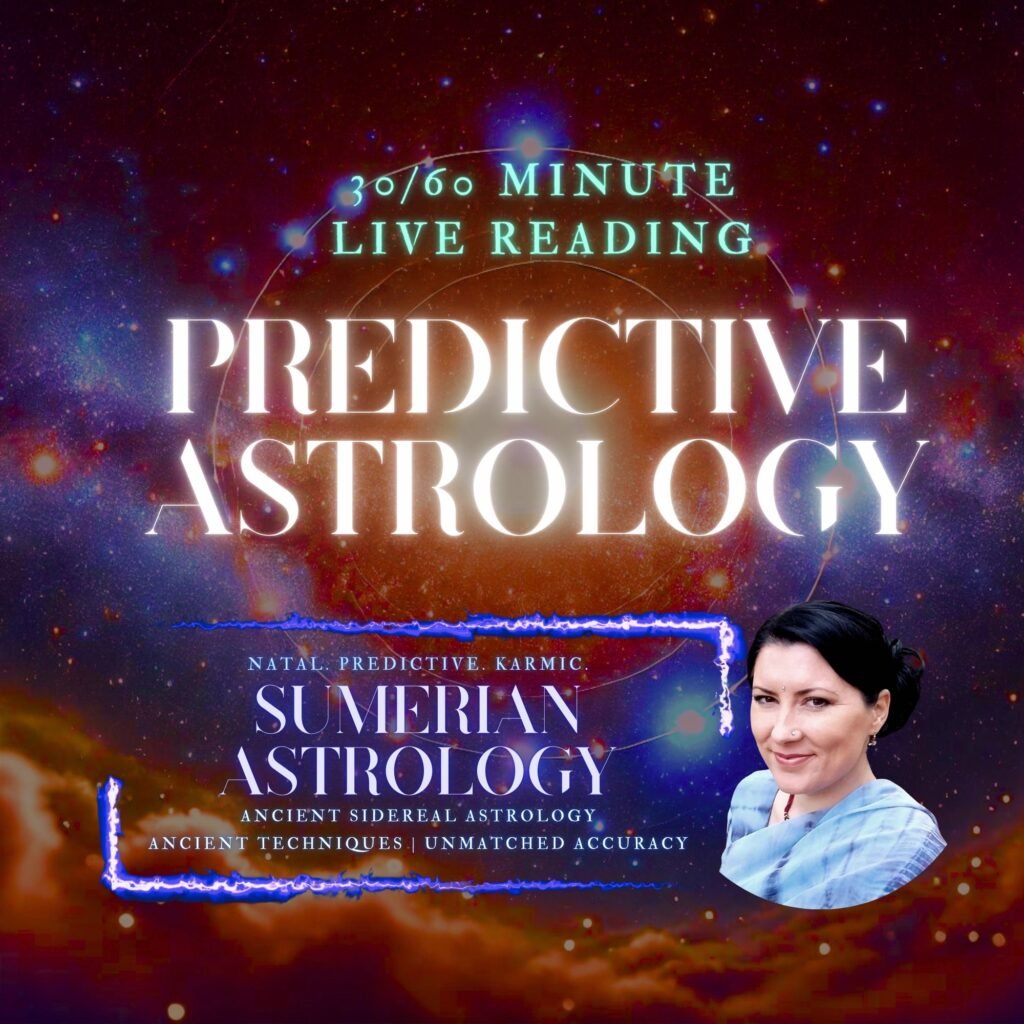
Predictive Astrology Reading
Want to know what’s ahead? A predictive astrology reading reveals upcoming opportunities, challenges, and cosmic cycles shaping your destiny. Get the clarity you need to plan wisely, make empowered choices, and align with the universe’s timing!
Makes a great birthday gift for you or your loved-one!
- Gain insight into upcoming life events
- Identify favorable periods for success
- Navigate challenges with confidence
- Align decisions with cosmic timing
- Maximize growth and opportunities
Explore Your Future’s Potential!
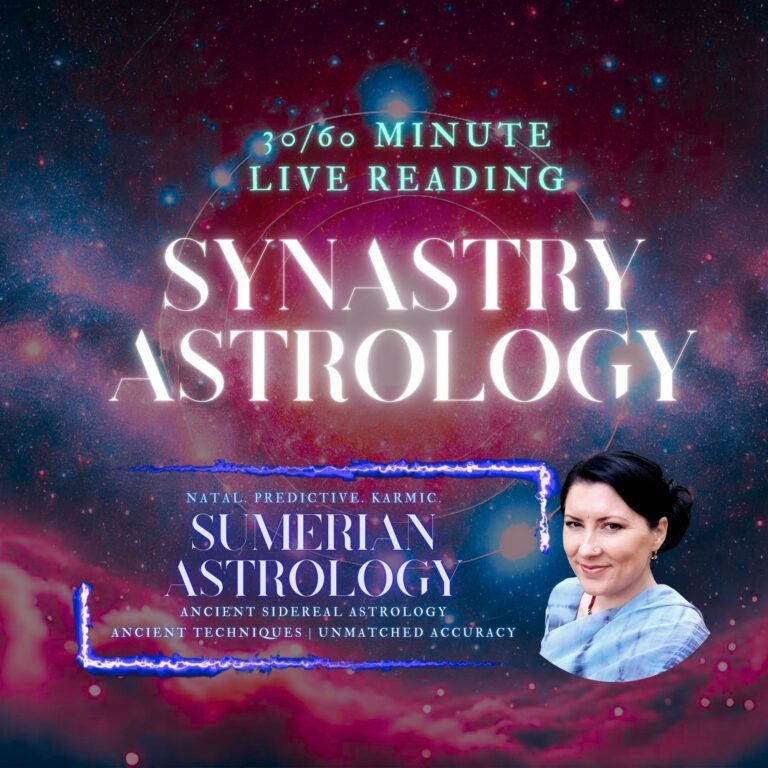
Synastry Astrology Reading
Relationship synastry is not just an excellent tool to help you understand a (potential) romantic partner. It can also be a great way to see how you’d work within a company, with a particular business partner, or even with country or currency!
It can also help you become a ware of potential issues, and even provide potential solutions long before problems ever arise!
- Understand your compatibility and dynamics
- Identify strengths and potential conflicts
- Improve communication and emotional connection
- Discover past-life karmic ties
- Navigate love and relationships with clarity
Discover the Secrets of Your Relationship!
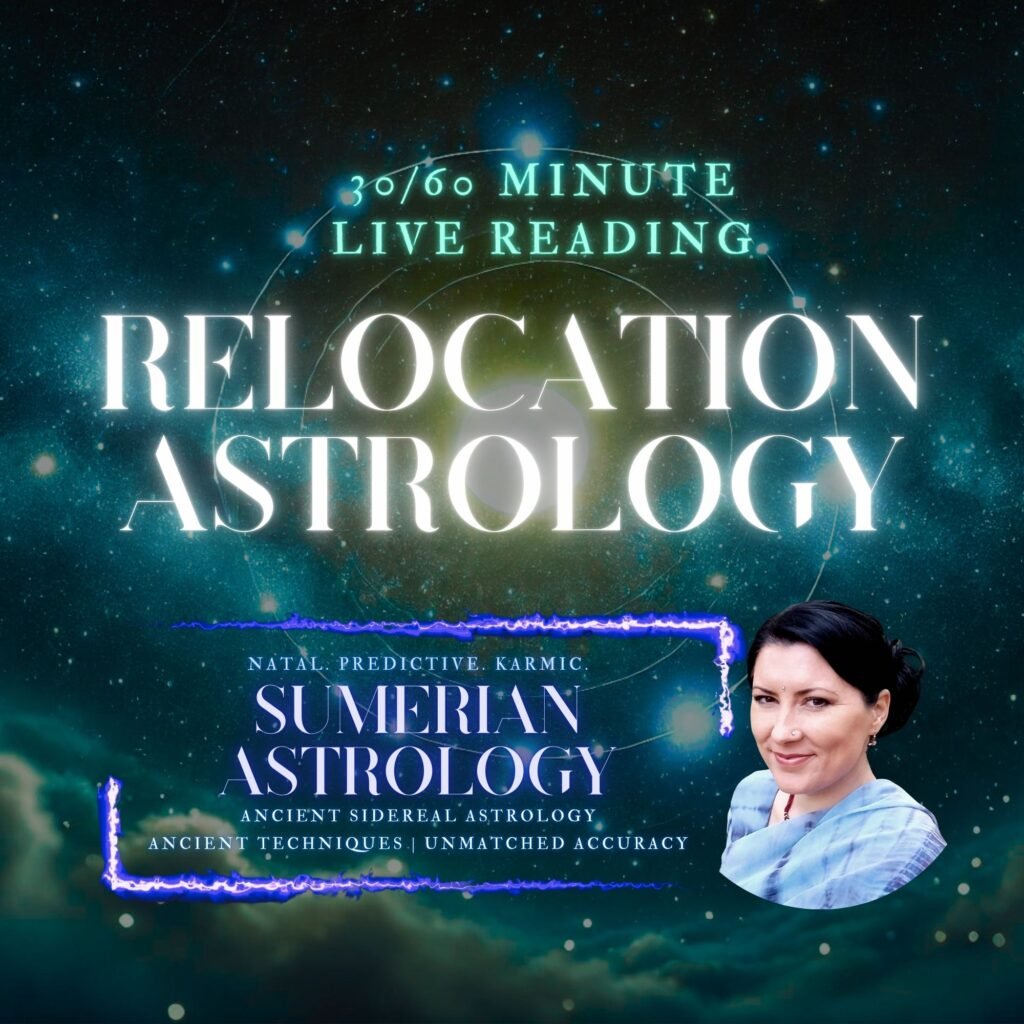
Relocation Astrology Reading
Not all locations are created equal! A relocation reading maps out the best places for you to thrive in all areas of life!
The vast majority of the time, the best locations for you are the ones you feel drawn to intuitively! If you want to get the most out of your astrocartography reading, create a list of 5 to 10 locations you’re considering, and we’ll outline the strengths and weaknesses of each, in addition to evaluating your planetary lines!
- Find your ideal city for success and happiness
- Discover where love and relationships thrive
- Uncover power zones for career and wealth
- Avoid challenging planetary influences
- Align with the best location for your soul’s journey
Find Your Best Place to Thrive!
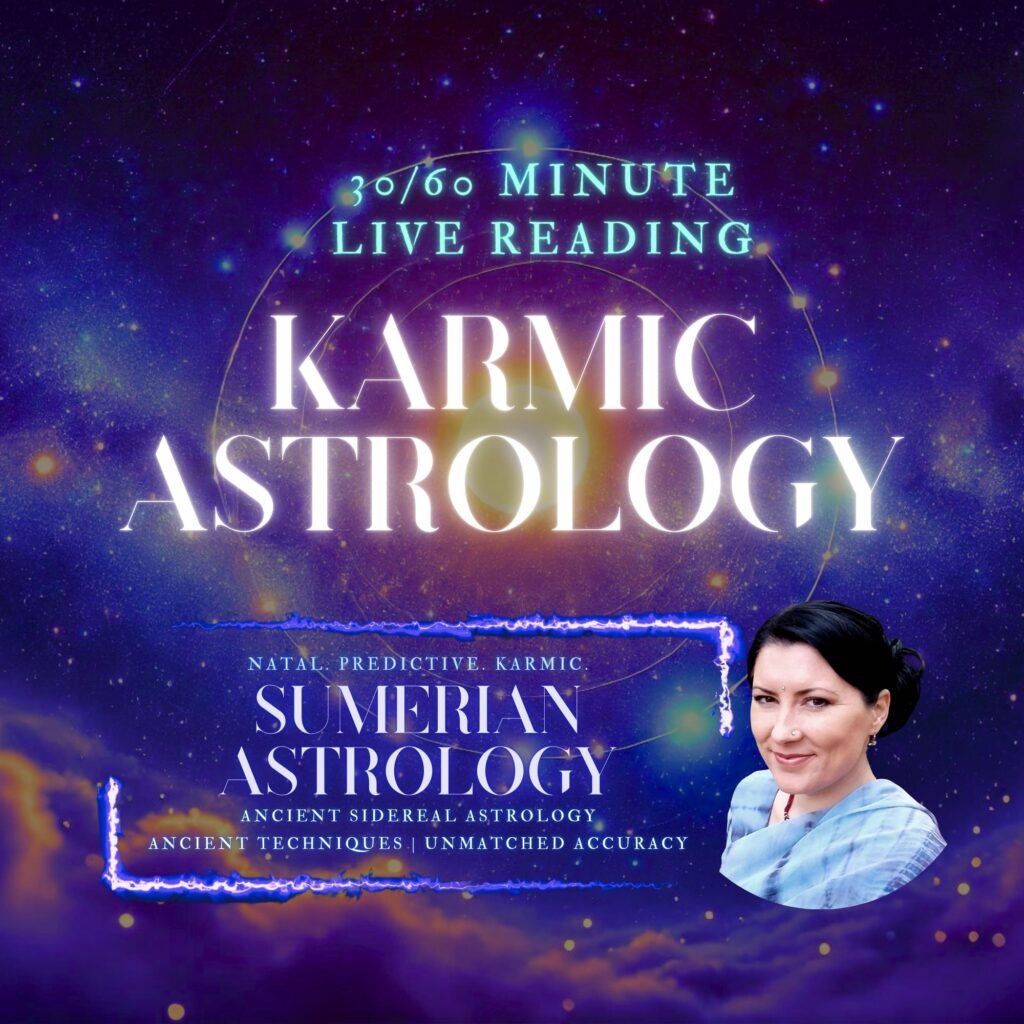
Karmic Astrology Reading
Your past lives hold the key to your present challenges and destiny! A karmic reading reveals past-life patterns, lessons, and unresolved karma so you can break cycles and step into your highest potential!
Don’t believe in pastlives? No problem! What we call ‘karmic’ issues can just as easily be explained as ancestral memory, childhood trauma, or other subconscious issues that aren’t readily explainable!
- Uncover past-life experiences affecting your present
- Understand karmic lessons and patterns
- Break free from negative cycles
- Gain insight into soul contracts and purpose
- Heal and align with your true path
Decode Your Past, Transform Your Future!
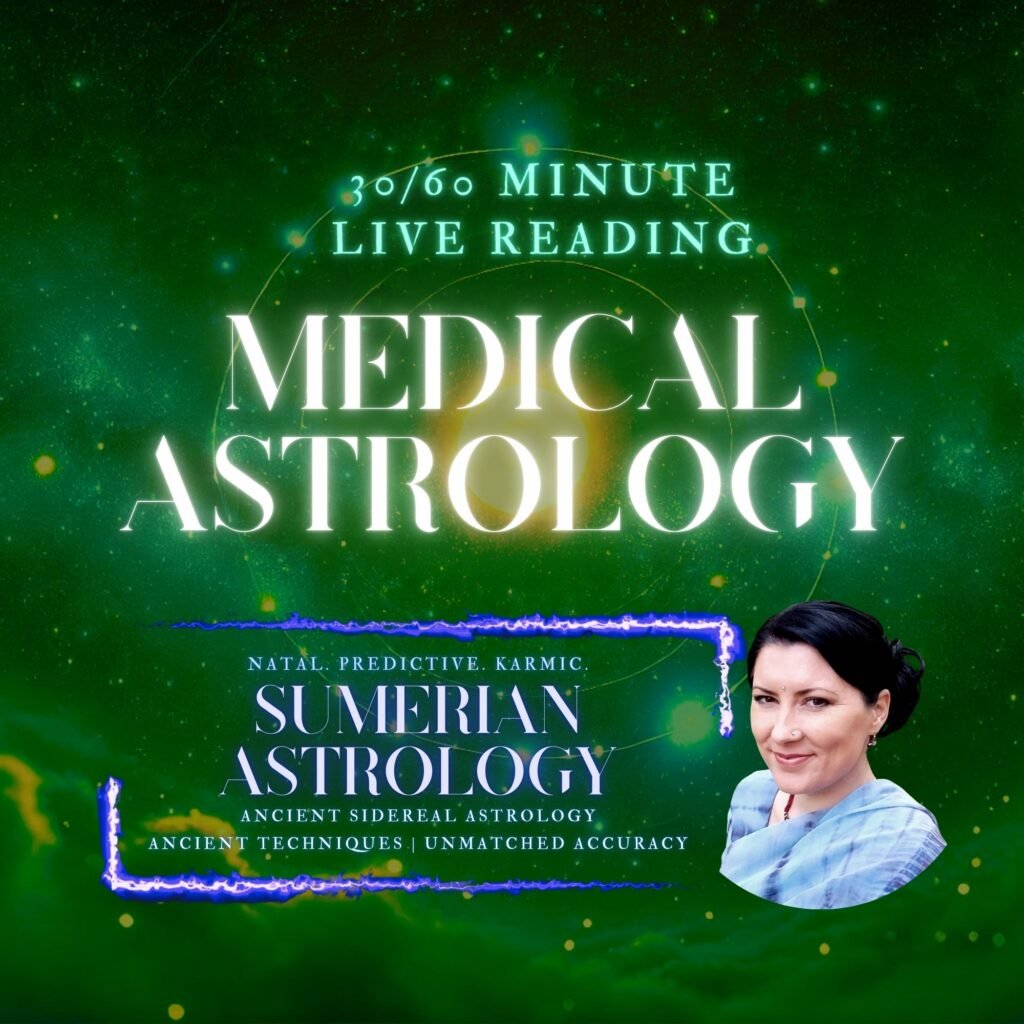
Medical Reading
A medical astrology reading can identify your body’s strengths, potential imbalances, and the best holistic approaches to healing based on your unique cosmic blueprint.
During my medical astrology readings, I also employ my extensive knowledge and work with chakras to supplement my ancient astrological expertise to give you the most detailed wellness information possible!
- Identify health strengths and vulnerabilities
- Discover natural remedies for your constitution
- Learn the best diet and lifestyle for you
- Understand stress triggers and energy patterns
- Align your healing journey with astrological timing
Align Your Body to the Heavens!

